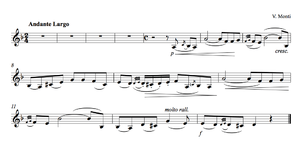Csárdás (Monti)

 |
|
| Problems playing this file? See media help. | |
"Csárdás" (or "Czardas") is a composition by Italian composer Vittorio Monti. A rhapsodical concert piece written in 1904, it is a well-known folkloric piece based on a Hungarian csárdás.[1] It was originally composed for violin, mandolin or piano.[2] There are arrangements for orchestra and for a number of solo instruments. The duration of the piece is about four and a half minutes.[2]
Structure
The piece has seven different sections, each one of a different tempo and occasionally key. The first half of the piece is in D minor, then modulates to D major, back to D minor, and then finally finishes in D major. The first section is Andante – Largo, followed by a large increase in speed to Allegro vivo. This then slows down to Molto meno. The piece then slows down more to Meno, quasi lento. The piece then suddenly picks up in pace and is at Allegro vivace. It then slows down to Allegretto and finally to Molto più vivo. The tempo changes make the piece exciting and interesting, but even with all of these tempo changes, it is generally expected that there should be some rubato to add feeling to the piece. There are also many different dynamic changes in the piece, ranging from pianissimo to fortissimo.
In the Meno, quasi lento section, the violin plays "artificial," "stopped," or (less accurately) "false" harmonics. This involves the violinist placing their finger down on the note and playing another note, with the finger only just touching the string 5 semitones above. This gives the effect of the violin sounding two octaves (24 semitones) higher.
Adaptations
- The British Film Institute database lists a 1927 short film made in the DeForest Phonofilm sound-on-film process by the Samehtini Trio, featuring this work played by a pianist and cellist.
- Sylvia Fine used the Allegro vivo section from this composition as the closing theme for her comic composition The Little Fiddle (Symphony for Unstrung Tongue), as performed by her husband, Danny Kaye, first in the movie The Secret Life of Walter Mitty, and afterward as a release on Decca Records.
- The theme is also prominently featured in the 1951 Bollywood movie Awaara.
- Grace Jones adapted a portion of the melody as an intro for her version of "Autumn Leaves" on her 1978 album Fame.
- It was a featured piece involving dueling violins in the 1984 film Unfaithfully Yours.
- Lady Gaga used part of Csárdás as an intro for her song "Alejandro" from her 2009 album The Fame Monster.
- Louis C.K. used this piece as part of the introduction to episode 6 "Subway/Pamela" from season 2 of his show Louie.
- Piano Tiles 2 an ios/Android rhythm app created by Cheetah Mobile use this song to the level.
Published scores
- Monti: Czardas per violino e pianoforte. Z. 13 700 (Editio Musica Budapest).
- The Celebrated Czardas by V. Monti F 102595 F (G. Ricordi & Co., London Limited)
References
External links
- Csárdás: Scores at the International Music Score Library Project
- Free sheet music of Csárdás from Cantorion.org
- Csárdás for violin and piano, Kreusch sheet music
- Czardas for violin and orchestra, Alberto Carcano on YouTube
- Csárdás for 12 pianists on 1 piano, arrangement by Haskell Small, TEDMED 2013
- Csárdás – Piano transcription on YouTube, performed by Geoffrey Storm
- Performed by Sophie Langdon, violin and Christopher Green-Armytage, piano, Philadelphia, 1979
- Csárdás – Solo piano arrangement on YouTube, Alexander Zlatkovski
- Csárdás – Guitar on YouTube, Janos Steiber
- Csárdás – Ukulele on YouTube, Brittni Paiva